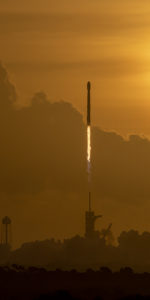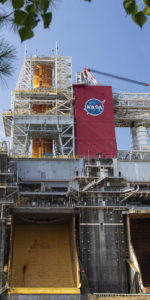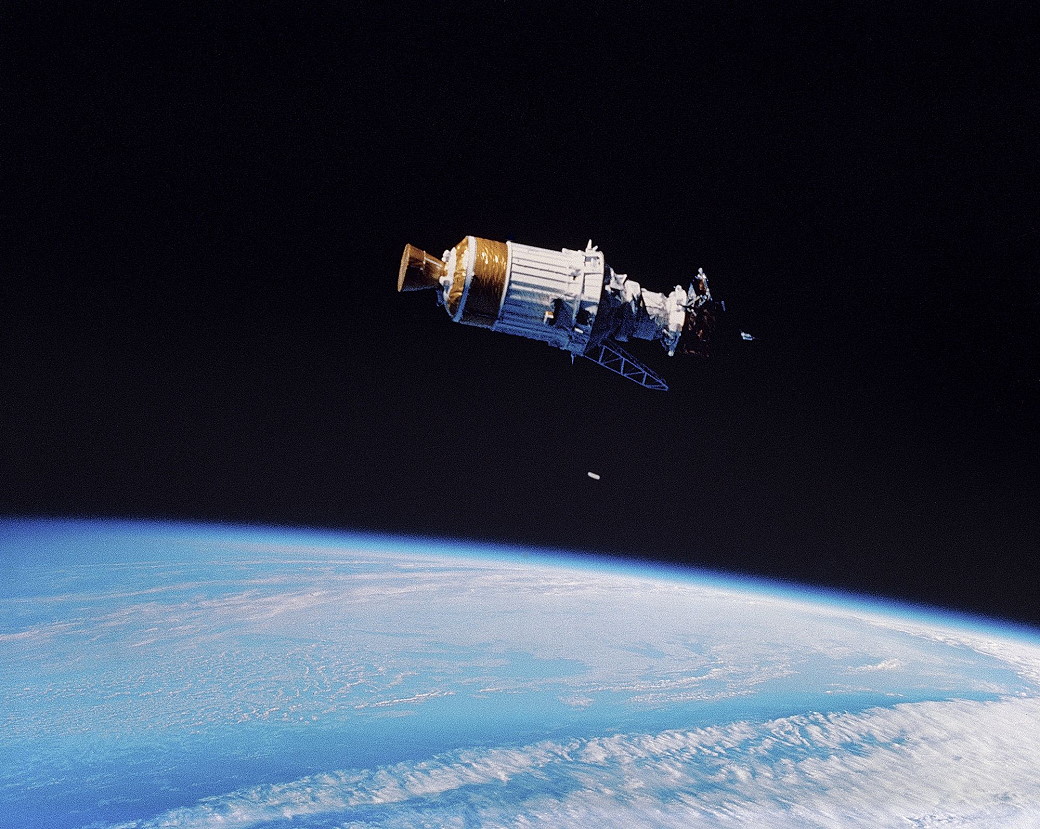
Three decades ago, today, on 6 October 1990, the crew of STS-41—Commander Dick Richards, Pilot Bob Cabana and Mission Specialists Bruce Melnick, Bill Shepherd and Tom Akers—launched the shuttle program’s fastest-ever Earth-departing payload: the joint U.S./European Ulysses probe, bound for an extended period of exploration of the solar poles. Over the next 19 years, until the end of its life in June 2009, Ulysses successfully passed over the Sun’s northern and southern polar regions no less than three times, as well as serendipitously passing through the coma-tails of three comets and observing giant Jupiter from afar.
Ulysses was the first spacecraft ever designed to venture beyond the “ecliptic plane”, allowing for studies of the Sun in three dimensions and affording us a chance to assess the total solar environment across a full range of heliographic latitudes. Since the ecliptic plane differs from the Sun’s equatorial plane by only 7.25 degrees, it was previously only possible to observe it from low latitudes. In the case of Ulysses, a program of high-latitude exploration was made possible by using the gravitational assistance of Jupiter.
Originally expected to launch in May 1986, Ulysses was intended to be delivered on itrs journey by General Dynamics’ liquid-fueled Centaur-G Prime upper stage, although this particularly hazardous booster was subsequently canceled in the aftermath of the Challenger tragedy. In its place was Boeing’s solid-fueled Inertial Upper Stage (IUS) and a smaller Payload Assist Module (PAM)-S, which, although less powerful, was far safer. And the launch of Ulysses was targeted for October 1990, with a narrow, 18-day “window” to ensure it could achieve its rendezvous with Jupiter in February 1992 and its first solar-polar passage in the 1994-1995 timeframe.
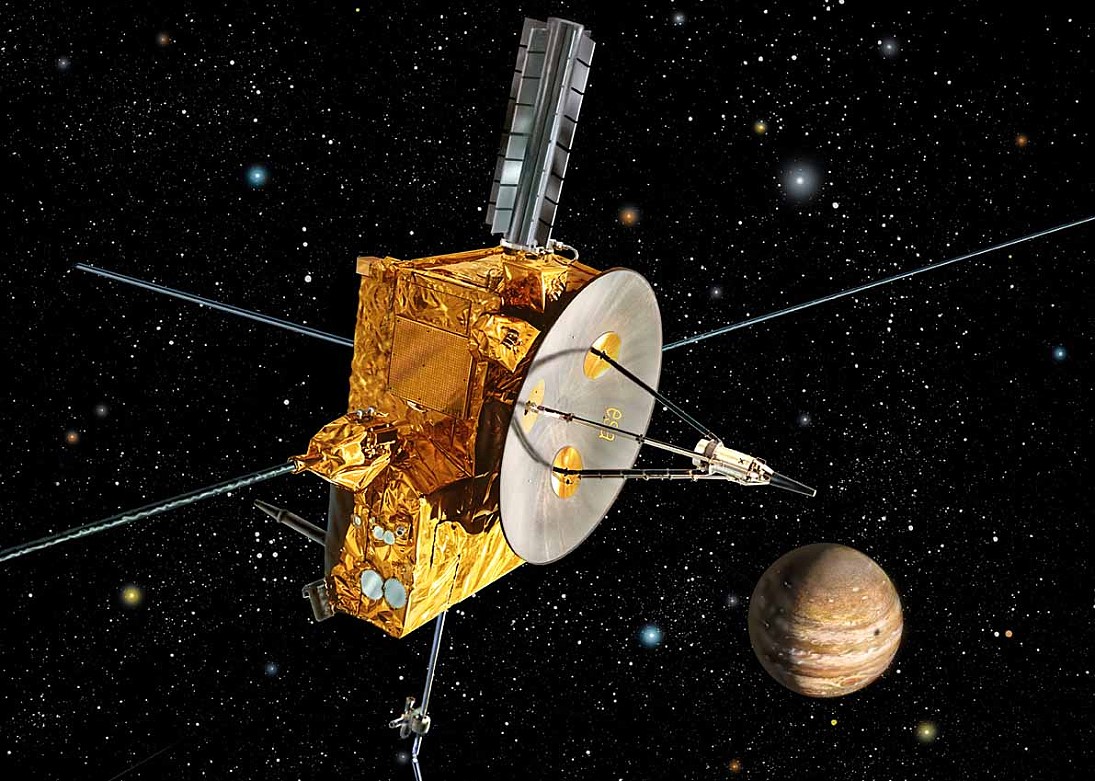
The STS-41 crew trained for about a year for their planned four-day mission. They were the first shuttle crew of whom none had flown in the pre-Challenger timeframe. Richards previously piloted STS-28 in August 1989, whilst Shepherd flew on STS-27 in December 1988, both of which were classified Department of Defense missions. Cabana, Melnick and Akers were all making their first flights. And for Melnick and Akers, STS-41 also marked the first time that members of NASA’s 1987 astronaut class had flown into space and this occasion was marked with a handmade placard in the launch pad “white room”, which bore the handwritten legend “Go ’87!”
Richards had rotated early into his first shuttle command, having only flown STS-28 a year before. However, having been selected as an astronaut in 1980, he had waited an unenviable nine years for his first mission—longer than any of his other classmates—and wryly described himself as “the plank-holder”. Years later, Richards guessed that NASA management felt they owed him a break and offered him an early command.
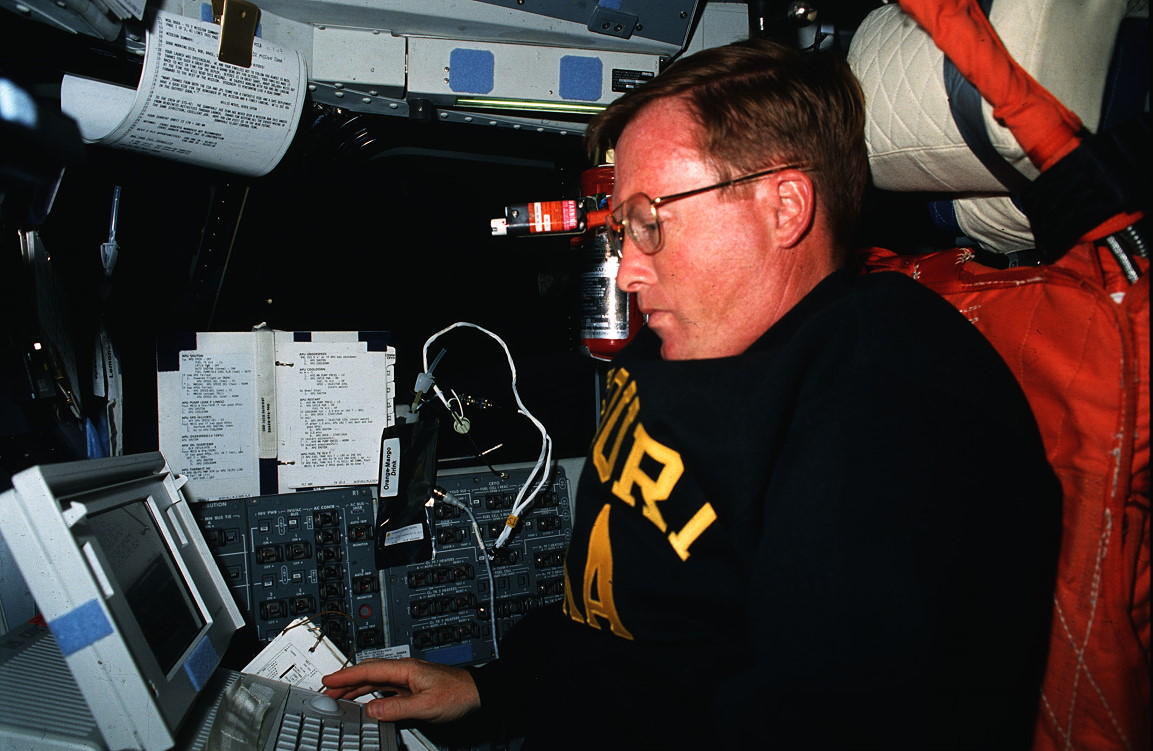
He saw it as his duty to ensure that the STS-41 crew was ready. “I had the luxury of nine years getting ready to go fly,” he told the NASA oral historian. “They didn’t have that much time.” Richards put together an impromptu crash course in shuttle systems and the five men gave each other weekly lectures to improve their knowledge. It proved both popular and unpopular, he remembered, but the end ultimately quantified the means.
“I spent a lot of time worrying about their systems knowledge and ship basics, because of their lack of shelf-life,” Richards added. “By the time we got done on that crew, we knew the vehicle backwards and forwards.”
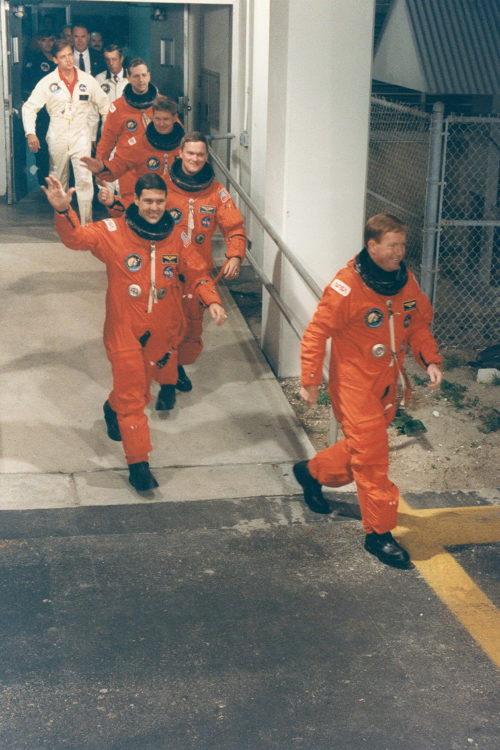
However, their launch at 7:47 a.m. EDT on 6 October 1990 came after a summer of agonizing delays, as Discovery’s sister shuttles Columbia and Atlantis endured an almost intractable series of hydrogen leaks. At one point, the delays manifested themselves in a remarkable “photo opportunity” as Columbia and Atlantis passed each other on the KSC crawlerway, one heading out to the launch pad, the other returning to the Vehicle Assembly Building (VAB) for repairs. For her part, Discovery’s processing flow for STS-41 was comparatively unblemished as Richards and his men headed out to KSC’s storied Pad 39B in the pre-dawn darkness.
“We were pretty happy at this point,” he recalled at the post-mission press conference, “because no flight crew had made it this far, at least being able to walk out to the Astrovan, in about six months, so we felt pretty good.”
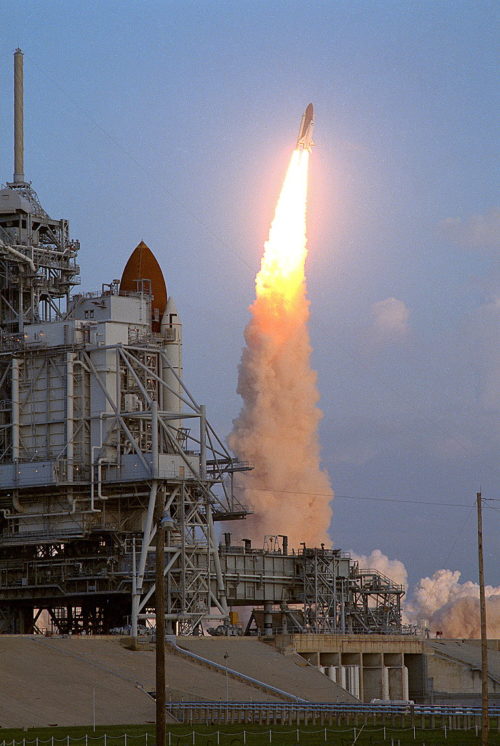
Liftoff came 12 minutes into the day’s 2.5-hour “window”, due to cloudy conditions at the Cape, and the mission marked Discovery’s heaviest to date, with the shuttle’s total weight sitting at 259,593 pounds (117,749 kg). “From a first-time flyer’s point of view, it was even more spectacular from the inside,” Cabana remembered. “It was an extremely smooth ride uphill, especially after we got off the solid rocket motors. It really surprised me how smooth the ride was.”
In the hours which followed, Akers and Melnick worked to prepare Ulysses and its combined IUS/PAM-S booster for deployment. This event was slated to occur at six hours and one minute after launch. Watching Akers work, Richards could not hide his admiration. “There was a time-critical bunch of steps,” he recalled, none more so than purging of coolant from Ulysses’ plutonium-powered Radioisotope Thermoelectric Generator (RTG). “Tom had to get down on this switch panel, which was, for some reason, located in this obscure corner of the flight deck.”
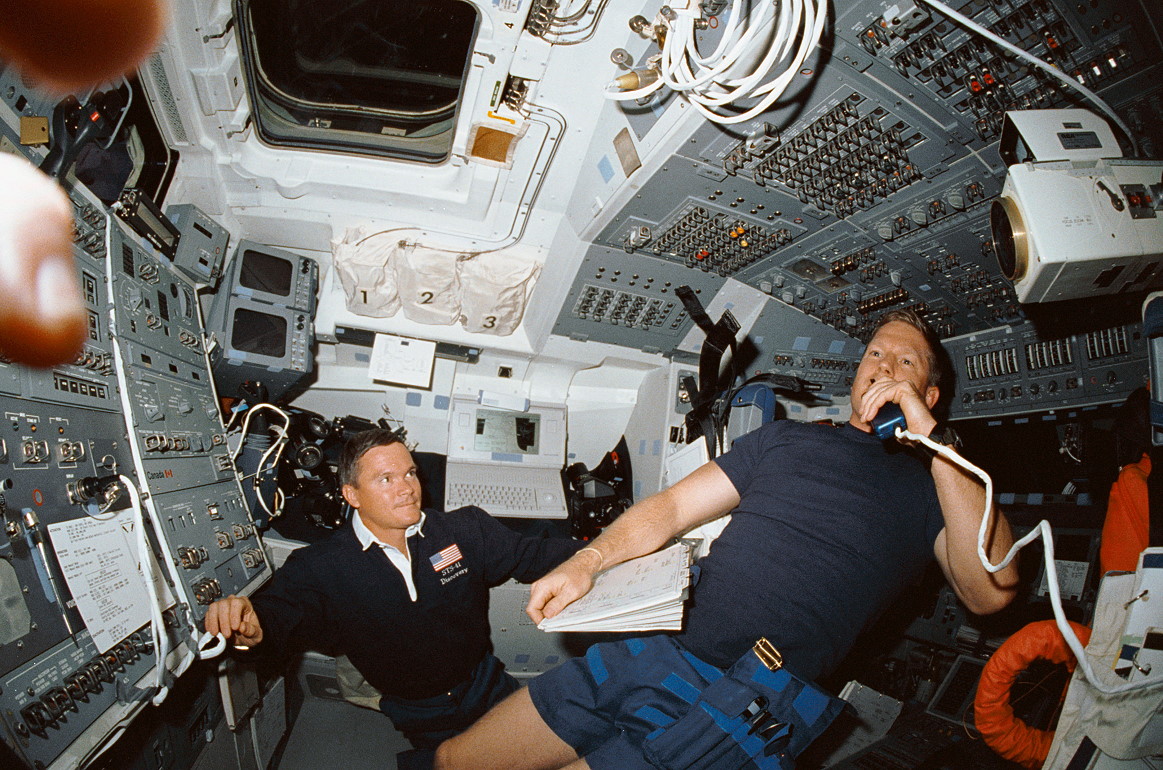
Step by critical step, the instant of deployment drew closer: forward payload restraints were released, the aft frame of the IUS’ support structure tilted the stack to an angle of 29 degrees, Richards and Cabana maneuvered to the correct attitude and electrical power was switched from the orbiter to the IUS. Finally, the three-minute purge of RTG coolant occurred, minutes before deployment.
As Akers worked, his crewmates anxiously eyed the clock, keenly aware that a few minutes hence Ulysses would have to be gone. It brought back memories from a couple of their pre-flight simulations, in which Akers had been momentarily late with switch throws, but Richards trusted him implicitly to complete the job and for a few minutes left him alone. At length, however, the anxiety was pressing.

“Tom?” he asked. “How you doing?”
Akers looked up from his work and gave a broad grin. “Never had so much time!”
The tension in Discovery’s cabin was broken and, a second earlier than intended—at six hours and 59 seconds Mission Elapsed Time (MET), in what the NASA Public Affairs Officer (PAO) described as “pretty good pointin’”—the ordnance to separate the IUS umbilical cables was activated and the stack was tilted to its deployment position of 58 degrees above the payload bay. Seemingly in slow motion, the spacecraft drifted smoothly and serenely away.

“Good deploy, Houston,” came the call from Discovery. “Ulysses is on its way.”
“That’s a great job!” replied Capcom Kathy Thornton.
The release itself occurred during orbital darkness, but as the shuttle approached sunrise, the sight of the Ulysses/IUS/PAM-S combo was, in Akers’ words, “a spectacular view”. Nineteen minutes later, Richards fired Discovery’s thrusters in a so-called “minus-X” maneuver, backing-off and providing a separation rate of 2.5 feet (0.7 meters) per second from the payload. That was followed, about 45 minutes after deployment, by the firing of the IUS’ first-stage engine, unseen by the astronauts, since Discovery had been reoriented with her belly facing Ulysses, thereby protecting her flight deck windows.
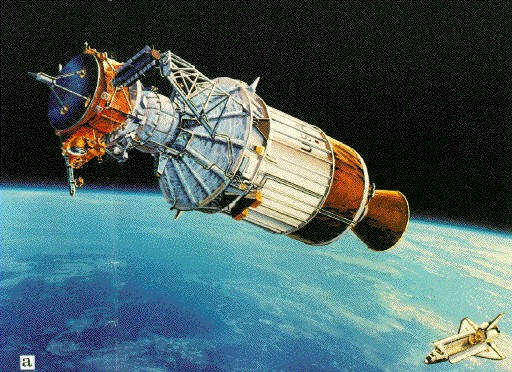
After burning for 150 seconds, the first stage was jettisoned and the second stage fired for two minutes, then separated. Next up was McDonnell Douglas’ PAM-S, which initially “spun-up” Ulysses to 70 revolutions per minute for stability, then executed an 88-second burn to provide the final velocity increment and set the spacecraft on course for a 16-month cruise to Jupiter.
Ulysses was then “yo-yo-despun”—with weights deployed at the end of cables—to less than eight revolutions per minute. Departing Earth’s gravitational “well” at 34,510 mph (55,538 km/h), the spacecraft became the fastest human-made machine to depart the Home Planet. It was a record that would remain unbroken until NASA’s New Horizons left Earth at an estimated 37,000 mph (59,000 km/h) in January 2006.
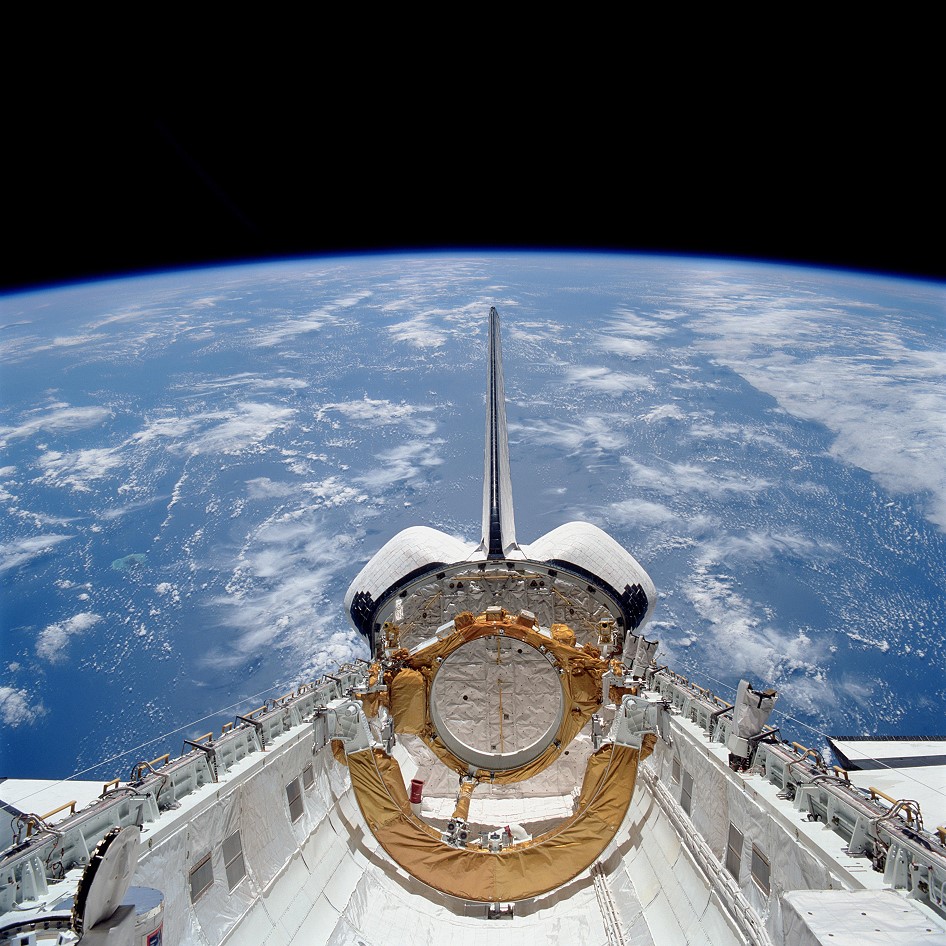
For the astronauts, their involvement with Ulysses now ended and responsibility passed to an army of flight controllers and trajectory specialists who would guide it toward a rendezvous with the Solar System’s largest planet in February 1992 and, later, for its exploration of the Sun.
Although the role of the STS-41 crew had been exclusively to launch Ulysses, they had undertaken several trips to Europe, and particularly Holland and Germany, where much of the contracting and project management was undertaken.
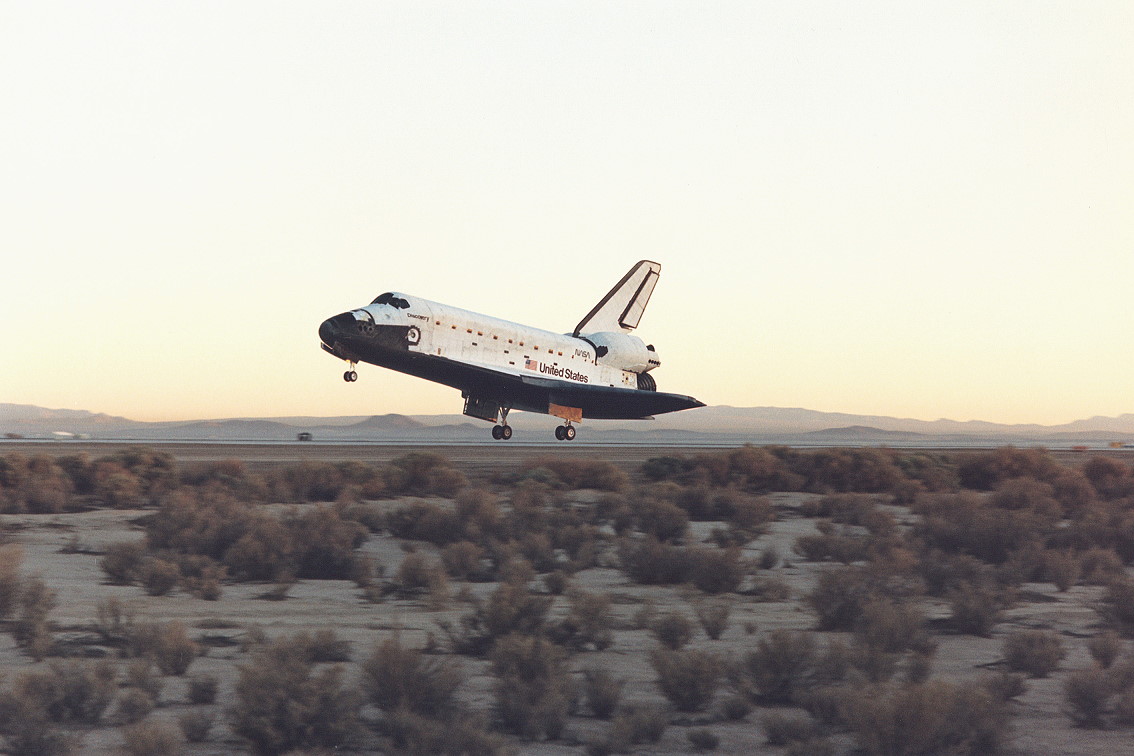
On one occasion, Richards recalled, it gave him a slightly unsettling introduction to European culture. At the end of each afternoon, the Germans would reach the end of their day, open up their cooler and pull out several kegs of beer. “We’d all sit around there, next to Ulysses,” he recalled, “toasting Ulysses and having beer. We didn’t do that here in the United States, so that was different. I kinda liked it.”
The remainder of the four-day mission was spent focusing upon middeck and payload bay experiments. Melnick and Akers went shirtless for a period, conducting the Blood Pressure Variability During Spaceflight investigation, part of Detailed Supplementary Objective (DSO)-602. As their televised bare torsoes were wired-up with electrodes, they jokingly announced that “We decided to run this for all the ladies down there in Mission Control”, to which Kathy Thornton replied “We are waiting, breathlessly!”
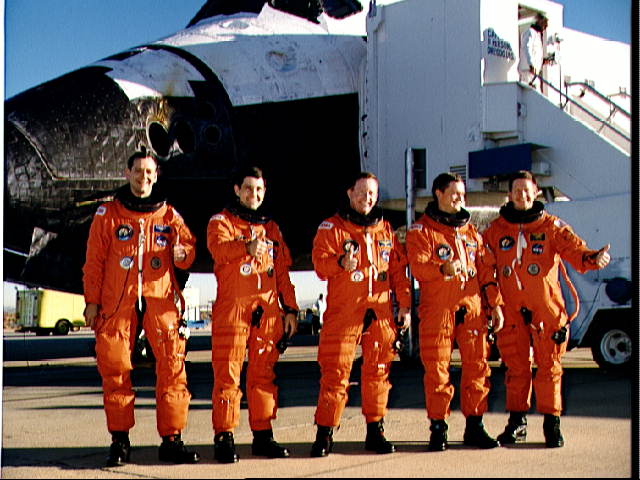
Additional experiments focused upon solar science, evaluations of materials in anticipation of the proposed retrieval of the Intelsat-603 communications satellite and solid-surface combustion studies. The crew also extended birthday greetings to Akers’ wife, Kaye, singing to her and producing a small cake, topped with a green-glowing “Kim-light” stick, in lieu of a candle.
After just 98 hours, Discovery completed her third-shortest flight of all time—eclipsed only by STS-26 and STS-51C—with a smooth touchdown at Edwards Air Force Base, Calif., at 6:57:18 a.m. PDT (9:57:18 a.m. EDT) on 10 October 1990. Backlit by a beautiful desert dawn, the shuttle swept across the mountains and alighted on Runway 22, rolling to a halt after just 49 seconds.
For Richards, it was too short a mission and he felt that the shuttle’s capabilities should have been monopolized by more time in orbit and more experiments. It was a point that he made during his post-mission debriefing and, as circumstances transpired, he went on to command the first Extended Duration Orbiter (EDO) mission two years later.
By that time, Ulysses herself had picked up an immense gravitational push from Jupiter and, over the following decade and a half, would complete no fewer than three passages over the Sun’s north and south poles. In so doing, the tiny spacecraft would reveal more about our parent star than had previously been acquired throughout human history.
.
.
FOLLOW AmericaSpace on Facebook and Twitter!
.
.




